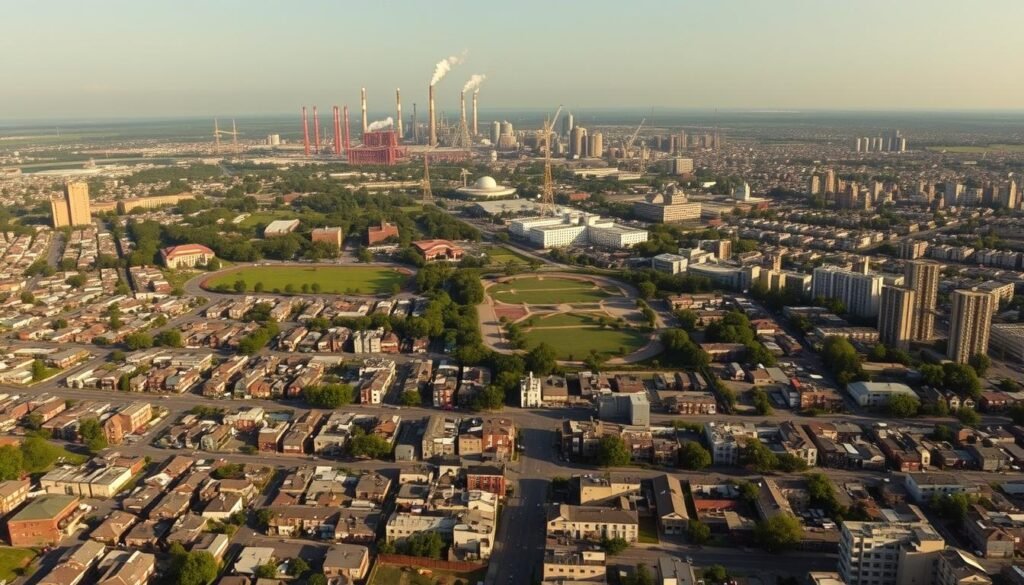What if the safety of your neighborhood’s air and water depended more on your income or skin color than on government regulations?
This question lies at the heart of environmental justice. It’s a movement fighting for fair treatment. All people deserve equal protection from environmental hazards.
Studies show poor and minority communities face more pollution exposure. They often live near hazardous waste sites. These areas suffer from poor air and water quality.
The movement began in the United States during the 1980s. It has since become global. It connects with fights for Indigenous land rights and human health.
This guide covers the history, key ideas, policies, and real cases. You’ll see how climate change hits vulnerable groups hardest. Natural disasters disproportionately affect marginalized groups.
Key Takeaways
- Environmental justice addresses unfair exposure to pollution in marginalized communities
- The movement began in the 1980s and has since expanded globally
- Studies consistently show racial and economic disparities in environmental hazard exposure
- Marginalized groups face disproportionate impacts from climate change and natural disasters
- The movement intersects with Indigenous land rights and human rights advocacy
- Environmental justice spans multiple disciplines including law, ecology, and social sciences
- This guide will explore historical roots, key concepts, and real-world case studies
Introduction to Environmental Justice
The location of hazardous waste sites often follows patterns of economic and racial segregation across America. This spatial injustice forms the foundation of a powerful social movement.
Environmental justice addresses how poor and marginalized groups face disproportionate harm from pollution. These communities receive few benefits from nearby industrial activities.
Hundreds of studies confirm this inequitable distribution of environmental harm. Research shows consistent patterns across different regions and hazard types.
Marginalized groups including Black and racialized communities face higher risks. LGBTQ populations also experience disproportionate impacts during natural disasters.
The United States Environmental Protection Agency provides a formal definition. It emphasizes fair treatment and meaningful involvement for all people.
This principle applies regardless of race, color, national origin, or income. It covers environmental laws, regulations, and policies.
The movement has evolved from its US origins to address global concerns. It now connects with broader human rights frameworks worldwide.
Environmental justice combines insights from multiple disciplines. Social science, political ecology, and sustainability theories all contribute.
Key concepts include environmental racism and distributive justice. Procedural justice ensures fair participation in decision-making processes.
These approaches help analyze how environmental burdens become concentrated. They reveal systemic patterns rather than random occurrences.
The Historical Roots of Environmental Justice in the United States
A powerful convergence of civil rights activism and ecological awareness gave birth to a transformative movement in the 1980s. This new approach connected pollution problems with social inequality in groundbreaking ways.
Marginalized groups began organizing against toxic facilities in their neighborhoods. They demanded equal protection from environmental hazards regardless of race or income.
The 1980s Movement Origins
The movement gained national attention through several key events. Warren County, North Carolina became a landmark case in 1982.
Local residents protested a PCB landfill in their community. This predominantly African American area became the face of a growing pattern.
Research from the United Church of Christ confirmed systemic disparities. Their 1987 study showed race was the strongest predictor of hazardous waste location.
This evidence supported what many communities already experienced firsthand. The term “environmental racism” entered public discourse during this period.
Influence of Civil Rights and Expansion
Early activists drew heavily from civil rights organizing strategies. They adapted protest methods and legal challenges to address ecological threats.
The movement initially focused on domestic issues within wealthy nations. Successful campaigns led to unexpected consequences elsewhere.
As regulations tightened in developed countries, corporations shifted operations. Extractivism and global waste trade moved environmental burdens to the Global South.
This expansion forced the movement to consider international dimensions. It began addressing gender, LGBTQ issues, and inequalities within marginalized groups.
Local conflicts involving environmental defenders confronting multinational corporations gained attention. These struggles connected with United Nations frameworks on human rights and healthy environments.
Indigenous land rights movements became crucial allies in this global expansion. Their fights for sovereignty and traditional territories aligned with environmental justice aims.
Defining Environmental Justice
How do we measure fairness when it comes to environmental protection? The answer lies in understanding three core principles that shape this important concept.
These frameworks help us see beyond simple pollution statistics. They reveal how systems and structures create unequal outcomes for different groups.
Distributive Justice: Equitable Risk Distribution
Distributive justice focuses on who bears environmental burdens and who receives benefits. It examines the geographic patterns of pollution exposure.
Some neighborhoods face multiple hazards from industrial facilities. Others enjoy cleaner air and better water quality.
This unequal distribution creates health disparities across communities. The impact falls heaviest on marginalized groups.
Procedural Justice: Fair Participation in Decisions
Procedural justice ensures all people have equal access to decision-making processes. It guarantees meaningful involvement in environmental policy.
This means community members must have real power in decisions affecting their neighborhoods. Their concerns should shape environmental laws and regulations.
True participation goes beyond just holding public meetings. It requires genuine fair treatment throughout the process.
Recognition Justice: Acknowledging Oppression
Recognition justice addresses historical patterns of discrimination. It acknowledges how race and color have influenced environmental conditions.
This framework validates the experiences of affected communities. It recognizes that environmental racism creates lasting effects on human health.
Scholar Robert D. Bullard expands these ideas into three equity categories. His work covers procedural, geographic, and social dimensions.
Procedural equity demands consistent rule application. Geographic equity examines spatial relationships to hazards.
Social equity analyzes how race, class, and ethnicity influence outcomes. It recognizes that people’s capacity to build flourishing communities varies greatly.
True environmental justice requires addressing all these dimensions simultaneously. Only then can we achieve equal protection for all people.
Environmental Racism and Inequity
Behind the statistics of pollution exposure lies a disturbing pattern where race and income determine environmental risk. This systemic problem represents a specific form of discrimination affecting marginalized groups.
Environmental racism describes how racial minorities face disproportionate harm from ecological threats. These communities experience higher exposure to industrial pollution and hazardous materials.
Low-income communities and people of color often work in the most dangerous occupations. They frequently reside in neighborhoods with poor air quality and contaminated water sources.
Children in these areas face particular vulnerability to environmental toxins. Playgrounds and homes become exposure sites for harmful substances that affect development.
Geographic equity examines how spatial relationships influence risk distribution. The placement of noxious facilities follows patterns of economic and racial segregation.
Locally unwanted land uses disproportionately affect communities of color. These include waste treatment plants, industrial factories, and hazardous waste sites.
Historical discrimination and current policies create compounding vulnerabilities. Poor neighborhoods with minority populations face triple threats from multiple hazards.
Health outcome differences reveal the human cost of these disparities. Respiratory illnesses, cancer rates, and developmental issues show clear patterns across demographic lines.
Addressing these inequities requires recognizing how race and class intersect with environmental policy. Meaningful change demands confronting systemic barriers that perpetuate harm.
Indigenous Environmental Justice
How do we approach fairness when legal systems themselves create inequality? This question lies at the heart of Indigenous perspectives on ecological equity.
Native American nations operate under separate legal frameworks. They are sovereign nations, not ethnic minorities within another system.
This distinction creates unique challenges for addressing environmental concerns. Mainstream approaches often fail to recognize these fundamental differences.
Unique Legal and Cultural Frameworks
Most Americans rely on EPA regulations and property-based laws. These systems assume private ownership and statutory protection.
Indigenous people follow different cultural and religious practices. Their relationship with land transcends legal ownership concepts.
Traditional knowledge shapes their understanding of ecological balance. This wisdom often conflicts with Western environmental policy.
Scholars like Kyle Powys Whyte expand the discourse beyond standard frameworks. They emphasize distinct relationships between Native communities and their territories.
Decolonization and Land Rights
The colonial condition informs Indigenous approaches to ecological equity. Historical displacement continues to affect current conditions.
Decolonization offers a potential framework for addressing these issues. It acknowledges how settler-colonialism created ongoing disparities.
Land rights become central to this conversation. The right to a clean environment as a human right sometimes contradicts Indigenous understandings.
Many Native cultures view land as sacred rather than property. This perspective changes how we define environmental benefits and risks.
True access to decision-making requires recognizing these fundamental differences. It means creating spaces for traditional knowledge in ecological decisions.
The work continues toward meaningful involvement for all people. This ensures better protection for human health across diverse communities.
Environmentalism of the Poor
Across the globe, those with the least resources often face the greatest ecological harm. This reality forms the core of a powerful idea called environmentalism of the poor.
Scholar Joan Martinez-Alier introduced this concept. It shows how marginalized groups bear heavy environmental burdens.
Wealthy nations often take resources from poorer countries. This extraction causes severe damage to land and water.
Low-income communities suffer the most from this damage. They live closest to pollution sources and hazardous sites.
Global South Exploitation
Many rich countries force resource removal from Global South nations. This practice creates long-term ecological and economic problems.
Oil drilling in Nigeria’s Ogoniland shows this pattern clearly. Shell Oil’s operations polluted the Niger River Delta badly.
A $1 billion cleanup was needed for the area. Local residents faced violent responses when they protested.
These actions highlight broader issues of power and control. They show how social inequalities drive ecological conflicts.
Local Conflicts and Transnational Networks
Fights over natural resources often start locally. But they can gain strength through global connections.
Transnational networks help spread awareness of these struggles. They build solidarity across borders for better outcomes.
University of Michigan research revealed troubling patterns. Over half of those near hazardous waste facilities lived in poverty.
This data confirms what many communities experience daily. It shows the need for fair treatment and meaningful involvement in decisions.
True change requires addressing these deep disparities. All people deserve equal protection from environmental hazards.
Slow Violence and Environmental Harm
Some dangers unfold so slowly they escape our notice until damage becomes irreversible. This invisible destruction forms the core of a powerful concept called slow violence.
Scholar Rob Nixon introduced this term in 2011. It describes harm that develops gradually across time and space.
Unlike sudden disasters, this damage accumulates unseen. It often goes unrecognized as violence despite its devastating effects.
Climate change represents a primary example. Rising temperatures and sea levels create gradual but catastrophic impacts.
Toxic drift from industrial sites poisons land and water over decades. Deforestation removes vital ecosystems piece by piece.
Oil spills continue affecting marine life long after cleanup efforts end. War leaves landscapes contaminated for generations.
These processes disproportionately affect vulnerable communities. Poor and marginalized groups bear the heaviest burdens.
Ecosystems suffer alongside human populations. The cumulative impact destabilizes both natural and social systems.
Involuntary displacement becomes common as areas become unlivable. People lose homes to creeping environmental degradation.
This desperation can fuel social conflicts over scarce resources. Community structures break down under prolonged stress.
Addressing these challenges requires new approaches to awareness. Movements must highlight gradual harm that escapes immediate attention.
Legal frameworks often struggle with timescales exceeding human lifespans. Policies must account for delayed consequences.
True protection demands recognizing all forms of environmental harm. Both sudden crises and gradual destruction deserve attention.
Critical Environmental Justice
Beyond conventional frameworks lies a more comprehensive approach to understanding environmental inequities. David Naguib Pellow developed this innovative perspective drawing from diverse theoretical traditions.
Critical Environmental Justice (CEJ) builds on anarchism, posthumanism, and intersectional feminism. It addresses limitations in traditional studies through four key pillars.
Pillar 1: Intersectionality of Inequalities
This pillar recognizes how different forms of oppression connect and overlap. Kimberlé Crenshaw’s intersectionality theory applies directly to ecological conflicts.
Race, class, gender, and other identities create complex disparities. These intersecting factors shape people’s experiences with environmental conditions.
Marginalized groups face compounded effects from multiple discrimination types. This approach reveals deeper patterns in how harm distributes across communities.
Pillar 2: Spatial and Temporal Scale
Environmental conflicts operate across different scales simultaneously. Local struggles connect to regional, national, and global patterns.
Scale itself reflects racial, gendered, and class-based disparities. The impact of ecological harm varies across time and space.
Multi-scalar methods help comprehend complex justice struggles. They show how immediate concerns relate to broader systemic issues.
Pillar 3: Solutions Beyond the State
This pillar questions reliance on government institutions alone. Social inequalities embed deeply in society and state power structures.
Alternative models offer different approaches to ecological decisions. The Common Ground Collective after Hurricane Katrina showed community-led possibilities.
Anarchist-inspired models prioritize direct action and mutual aid. They create spaces for meaningful involvement outside formal policy channels.
Pillar 4: Indispensability of Marginalized Groups
This final pillar counters ideologies that view certain populations as expendable. It centers marginalized people as essential to collective futures.
Racial indispensability and socioecological indispensability are key concepts. They affirm the value all communities bring to environmental benefits.
This perspective transforms how we view participation and access. It recognizes that true justice requires everyone’s contributions.
Key Environmental Justice Movements
Local conflicts over pollution and resources have sparked powerful global campaigns for fair treatment. These movements give voice to those most affected by industrial hazards.
Marginalized communities fight for agency in decisions that shape their living conditions. They challenge powerful corporations through organized action.
The Warren County PCB protests became a landmark case in 1982. Residents opposed a toxic waste dump in their North Carolina neighborhood.
This African American minority community drew national attention to systemic disparities. Their struggle inspired similar actions across the country.
Global networks now connect local defenders facing multinational corporations. These alliances strengthen community efforts against resource extraction.
Transnational support influences outcomes in once-isolated conflicts. Shared strategies emerge across different cultures and practices.
Movement tactics include litigation, organizing, and direct action. Many groups combine multiple approaches for greater impact.
Early efforts often reacted to existing threats. Modern movements increasingly lead proactive initiatives.
Community-led projects address local concerns while creating broader benefits. They demonstrate alternative approaches to ecological decisions.
Academic research supports these efforts through documentation and analysis. Scholars produce interdisciplinary studies highlighting movement achievements.
This scholarship helps validate community experiences with environmental harm. It provides evidence for policy changes and legal challenges.
The work continues toward meaningful involvement for all people. True change requires fair access to decision-making spaces.
Environmental Disparities in the United States
Statistical patterns reveal troubling connections between zip codes and health outcomes across America. Where you live often determines what hazards you face daily.
Research consistently shows that your address can predict your exposure to pollution. This reality creates significant health differences between neighborhoods.
Racial and Income-Based Exposure to Hazards
University of Michigan researchers made a startling discovery. Over half of those living near hazardous waste facilities were living in poverty.
This pattern holds true across different regions and facility types. Low-income communities consistently face higher risks from industrial operations.
Race also plays a significant role in hazard distribution. The EPA examined populations around 1,881 Superfund sites nationwide.
Their findings showed disproportionate impact on marginalized groups. People of color often live closest to the most dangerous facilities.
Historical policies like redlining created lasting effects. Discriminatory zoning practices concentrated pollution in certain areas.
These decisions from decades ago still affect current conditions. They created patterns that continue to harm residents today.
Health Impacts and Statistics
The CDC documents clear trends in health outcomes. Racial and ethnic disparities appear across multiple environmental exposure types.
Asthma rates show particularly concerning patterns. Children in polluted neighborhoods experience more breathing problems.
Cancer incidence also varies by geographic location. Some communities face significantly higher risks than others.
Hazardous substances affect human health in multiple ways. Lead poisoning and water contamination create long-term problems.
These public health issues connect directly to environmental factors. Where people live influences how they live.
Poverty and race intersect to create compounded vulnerabilities. The poorest communities often face the greatest hazards.
Addressing these issues requires understanding their complex nature. True justice demands equal protection for all citizens.
U.S. Environmental Justice Policies and Laws
How do government actions translate into real protection for vulnerable neighborhoods? The answer lies in understanding America’s evolving legal frameworks for ecological equity.
Federal and state governments have developed specific approaches to address historical imbalances. These systems aim to ensure equal protection from environmental hazards.
EPA Definitions and Initiatives
The Environmental Protection Agency provides crucial guidance on this issue. Their definition centers on fair treatment for all people regardless of background.
This principle emphasizes meaningful involvement in decisions affecting local conditions. It ensures community voices shape environmental policy.
The Toxics Release Inventory Program tracks chemical releases nationwide. This data helps identify pollution patterns across different communities.
Another initiative addresses power plant impacts on neighboring areas. It focuses on disproportionate effects on vulnerable populations.
These programs provide tools for measuring environmental quality. They help document health disparities related to industrial hazards.
Recent Legislative Advances
New laws represent significant progress in addressing historical inequities. The Inflation Reduction Act includes substantial provisions for ecological equity.
This legislation directs resources toward marginalized communities. It aims to rectify past environmental injustices through targeted investments.
The Justice40 Initiative takes a comprehensive government approach. It ensures 40% of certain federal benefits reach disadvantaged communities.
These policies work alongside state-level environmental laws. Together they create a multi-layered system of protection.
Implementation challenges remain despite these advances. Measuring effectiveness requires ongoing evaluation of real-world impact.
Regulatory frameworks continue evolving to ensure proper enforcement. They address both historical inequities and future prevention measures.
These efforts represent America’s commitment to equal access to clean environments. The work continues toward truly fair treatment for all citizens.
Case Studies: Environmental Justice in Action
Real-world struggles reveal how communities fight against unfair pollution burdens. These cases show both the challenges and successes of grassroots movements.
Shell Oil’s operations in Nigeria’s Ogoniland created severe environmental degradation. Their drilling polluted the Niger River Delta for decades.
A $1 billion cleanup was finally required. This massive project addressed years of damage to land and water.
Ogoni residents organized large-scale protests against the pollution. Ken Saro-Wiwa led this resistance movement with great courage.
Government and corporate responses turned violent against protesters. The Ogoni Nine faced arrests and eventual executions.
This suppression drew international attention to the conflict. It became a global symbol of corporate accountability struggles.
In the United States, hazardous waste facility siting shows clear patterns. These sites often appear near minority communities.
Superfund cleanup processes directly affect surrounding neighborhoods. The impact on local residents varies greatly by location.
Some low-income communities wait years for proper remediation. Others see quicker action based on political pressure.
Community-led responses to industrial pollution demonstrate grassroots power. Residents organize when official systems fail them.
The Common Ground Collective formed after Hurricane Katrina. This model showed community-based response outside state systems.
Volunteers provided mutual aid and disaster relief directly. They operated without waiting for government approval or funding.
These case studies reveal both painful losses and significant victories. Legal outcomes sometimes bring policy changes that benefit people.
Some campaigns achieve cleaner environments for affected neighborhoods. Others establish important precedents for future fights.
The lessons inform movement strategies and policy development. Each struggle contributes to broader understanding of ecological equity.
True justice requires learning from these real-world examples. They show the importance of meaningful involvement in all decisions.
The Role of Climate Change in Environmental Justice
When natural disasters strike, they don’t affect all neighborhoods equally. Climate change amplifies existing inequalities in dangerous ways.
Vulnerable groups face the hardest impact from extreme weather events. Poor communities and people of color bear disproportionate burdens.
The EPA documents clear connections between rising temperatures and human health risks. Heat waves and poor air quality create serious public health challenges.
Marginalized populations often live in areas with inadequate infrastructure. They face higher exposure to climate-related hazards.
Historical emission patterns create current responsibilities. Wealthy nations produced most greenhouse gases historically.
Yet developing countries experience the severest effects. This imbalance raises questions about fairness and accountability.
Climate finance represents an emerging solution concept. It addresses adaptation needs and loss compensation.
Gender disparities appear in vulnerability assessments worldwide. Women often face greater risks during climate emergencies.
Indigenous populations protect vast natural resources globally. Their traditional practices offer valuable climate solutions.
Energy transition policies must consider equity concerns. Green technologies should benefit rather than burden vulnerable residents.
Climate-induced migration creates new justice challenges. Displaced populations need protection and support.
Resilience planning helps communities prepare for multiple stressors. It combines environmental protection with social support systems.
True climate justice requires addressing these interconnected issues. It demands fair solutions that protect everyone equally.
Community Advocacy and Meaningful Involvement
What happens when community voices shape environmental decisions rather than just react to them? This question lies at the heart of genuine participation in ecological matters.
Meaningful involvement transforms how we approach local concerns. It moves beyond token meetings to real collaboration.
Communities gain power in decisions affecting their neighborhoods. They help design solutions rather than just receive finished plans.
This approach addresses adverse conditions caused by industrial impact. It provides individuals opportunities to participate directly.
True engagement requires listening to resident experiences. Local knowledge often reveals solutions outsiders miss.
Prioritizing community concerns builds equitable, inclusive societies. It ensures investments match actual needs rather than assumptions.
Sustainable communities emerge from this collaborative process. They combine environmental protection with social benefits.
Economic opportunities and workforce training become natural outcomes. High-quality jobs follow community-centered planning.
Technology enhances participation through digital tools and platforms. Virtual meetings and online surveys increase access.
Diverse contexts require adaptable engagement practices. What works in urban areas might differ from rural approaches.
Democratic environmental governance depends on this involvement. It connects local actions with broader policy decisions.
The relationship between participation and outcomes becomes clearer. Communities see direct results from their input.
This process represents the heart of environmental justice work. It ensures all people receive fair treatment and protection.
Future Directions for Environmental Justice
What new frontiers will shape the next chapter of equitable environmental protection? The movement continues evolving toward more comprehensive approaches.
Critical frameworks expand traditional thinking about ecological equity. They incorporate intersectional analysis and multi-scalar approaches.
Climate considerations are transforming standard environmental justice methods. Rising temperatures create new vulnerabilities for marginalized communities.
Energy transitions present both challenges and opportunities. The shift to renewables must benefit rather than burden vulnerable residents.
Policy development trends show movement toward more inclusive measures. Governments are creating comprehensive approaches to address historical inequities.
Global coordination efforts are strengthening transnational responses. International networks help address pollution that crosses borders.
Technological advancements provide powerful new monitoring tools. Satellite data and air quality sensors document disparities in real time.
Data accessibility improvements transform research and advocacy capabilities. Open information platforms help communities track local environmental conditions.
Emerging concepts like energy democracy are gaining traction. These ideas center community control over power generation and distribution.
Corporate accountability mechanisms continue developing worldwide. New legal frameworks address ecological debt and responsibility.
Future directions must address both historical wrongs and new challenges. The relationship with broader sustainability movements keeps evolving.
These developments represent the growing sophistication of equity work. They offer hope for more effective protection for all people.
Conclusion
Ensuring equal protection from ecological harm remains a critical global challenge. The movement for environmental justice has grown from local protests to worldwide action.
It continues to center community voices in all decisions. Meaningful involvement ensures policies reflect real needs.
Future progress requires innovative approaches beyond traditional systems. Addressing intersectional inequalities is essential for true equity.
Marginalized groups must lead these efforts for lasting change. Their leadership creates more sustainable and fair societies for everyone.
FAQ
What is environmental justice?
It’s the fair treatment and meaningful involvement of all people regarding laws and policies. This applies regardless of race or income. The goal is to protect health and the environment for everyone.
How does climate change relate to this issue?
Climate impacts, like extreme heat and flooding, often hit low-income and minority communities hardest. These groups have fewer resources to adapt, worsening existing disparities.
What is environmental racism?
It refers to policies or practices that unfairly burden communities of color with health hazards. This includes placing polluting industries or waste sites in their neighborhoods.
What does "meaningful involvement" mean?
It means affected residents must have a real say in decisions that impact their health and land. Their voices should guide policies from the start, not just be heard after plans are made.
Are there laws to address these disparities?
Yes. In the United States, various federal and state laws aim to reduce inequities. Recent policies, like the Justice40 Initiative, direct benefits to disadvantaged areas.
How does this affect public health?
Higher exposure to air pollution and toxic sites leads to more health problems. These include asthma, heart conditions, and cancer in overburdened populations.
What role do community groups play?
Local advocates are essential. They fight for cleaner air, safe water, and equitable land use. Their work pushes for accountability and sustainable solutions.







